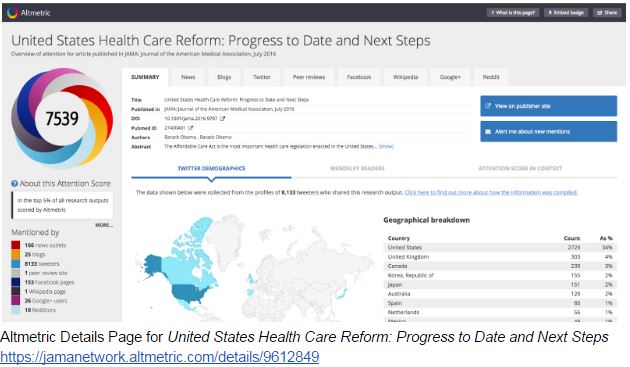Why should a bibliometrician engage with altmetrics? Guest Post by Natalia Madjarevic
Last month, Barack Obama published an article in the journal JAMA discussing progress to date with The Affordable Care Act
– or Obamacare – and outlining recommendations for future policy
makers. Obama’s article was picked up in the press and across social
media immediately. We can see in the Altmetric Details Page that it was shared across a broad range of online attent
 ion
ionsources such as mainstream media, Twitter, Facebook, Wikipedia and
commented on by several research blogs. We can also see from the stats
provided by JAMA that the article, at time of writing, has been viewed
over 1 million times and has an Altmetric Attention Score of 7539, but
hasn’t yet received a single citation.
Providing instant feedback
Many altmetrics providers track attention to a research output as
soon as it’s available online. This means institutions can then use
altmetrics data to monitor research engagement right away, without the
delay we often see in the citation feedback loop.
If President Obama was checking his Altmetric Details Page
(which I hope he did!) he’d have known almost in real-time exactly who
was saying what about his article. In the same way, academic research
from your institution is generating online activity – probably right
now – and can provide extra insights to help enhance your bibliometric
reporting.

Altmetric, which has tracked mentions and shares of over 5.4m
individual research outputs to date, sees 360 mentions per minute – a
huge amount of online activity that can be monitored and reported on to
help evidence additional signals of institutional research impact. That
said, altmetrics are not designed to replace traditional measures such
as citations and peer-review and it’s valuable report on a broad range
of indicators. Altmetrics are complementary rather than a replacement
for traditional bibliometrics.
Altmetrics reporting: context is key
Using a single number, “This output received 100 citations” or “This
output has an Altmetric Attention Score of 100” doesn’t really say that
much. That’s why altmetrics tools often focus on pulling out the
qualitative data, i.e. the underlying mentions an output has received.
Saying, “This output has an Altmetric Attention Score of 100, was
referenced in a policy document, tweeted by a medical practitioner and
shared on Facebook by a think tank” is much more meaningful than a
single number. It also tells a much more compelling story about the
influence and societal reach of your research. So when using altmetrics
data, zoom in and take a look at the mentions. That’s where you’ll find
the interesting stories about your research attention to include in your
reporting.
How can you use altmetrics to extend your bibliometrics service?
Here are some ideas:
- Include altmetrics data in your monthly bibliometric reports to
demonstrate societal research engagement – pull out some qualitative
highlights - Embed altmetrics in your bibliometrics training sessions and welcome emails to new faculty – we have lots of slides you can re-use here
- Provide advice to researchers on how to promote themselves online and embed altmetrics data in their CV
- Encourage responsible use of metrics as discussed in the Leiden Manifesto and The Metric Tide
- Don’t use altmetrics as a predictor for citations! Use them instead
to gain a more well-rounded, coherent insight into engagement and
dissemination of your research
existing services and provide researchers with a more granular and
informative data about engagement with their research. The first step is
to start exploring the data – from there you can determine how it will
fit best into your current workflow and activities.
Further reading
- Tips & Tricks: promoting your research online – flyer for researchers [PDF]
- A Beginners Guide to Altmetrics [Video]
- The Metric Tide – http://www.hefce.ac.uk/pubs/rereports/Year/2015/metrictide/
- NISO Altmetrics Initiative – http://www.niso.org/topics/tl/altmetrics_initiative/
- Advice from a librarian: how to do successful altmetrics outreach – https://www.altmetric.com/blog/advice-from-a-librarian/
- Explorer for Institutions – https://www.altmetric.com/products/explorer-for-institutions/
@nataliafay
Why should a bibliometrician engage with altmetrics? Guest Post by Natalia Madjarevic – the Bibliomagician
No comments:
Post a Comment